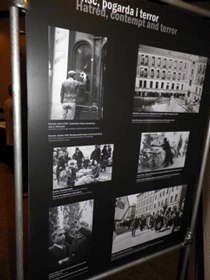January 15, 2013
Righteous Among the Nations exhibit coming to Hale

An exhibit titled “Righteous Among the Nations” is coming to Hale Library and is free and open to the public after its ribbon-cutting ceremony 4:30 p.m. Monday, Feb. 4. The exhibit will be on display for the month of February, and school groups are encouraged to visit.
The Righteous Among the Nations is an honorary decoration conferred by the State of Israel to honor non-Jews who saved Jewish men, women and children from extermination by the Nazis. The title of the Righteous Among the Nations is given to those who — in a world of absolute moral collapse — rose above simple courage and became heroes and defenders of humanity.
“This exhibit is a powerful tribute to extraordinary actions in terrifying times,” said Susan Yelich Biniecki, event organizer and assistant professor in the College of Education. “We would like to invite the entire Kansas community to participate throughout the month of February. We are honored that Consul General Paulina Kapuścińska from the Consulate General of the Republic of Poland in Chicago will be here to formally open the exhibit at the ribbon cutting as well as recognize Kansas connections to telling the story of one of the heroes, Irena Sendler.”
Sendler smuggled children out of the Warsaw Ghetto, and her story may have been lost to the ages if not for a class project by teacher Norman Conard and three of his students in Uniontown, a small community in southeast Kansas. The students became so consumed by Sendler’s story — the Nazis tortured her and broke her legs and feet — that they wrote a play titled “Life in a Jar” because that’s where Sendler stored the names of the 2,500 children she helped cheat probable death.
The College of Education, K-State Libraries and the School of Leadership Studies coordinated campus efforts for this educational exhibit.
College of Education Dean Debbie Mercer said it's an honor to highlight the exhibit at its first university viewing.
“We are thrilled to be part of telling this important story and for all of the educational opportunities an exhibit of this caliber brings with it,” she said.
The following information about the exhibit was provided by the Consulate General of the Republic of Poland in Chicago:
The exhibit is a tribute to some of the Polish Righteous Among the Nations: a group of seemingly ordinary men and women living in southern Poland who demonstrated extraordinary courage and risked their own lives, and the lives of their families, to help the Jews survive the Holocaust. Even though the subject matter of the exhibit is difficult, the message it carries is overwhelmingly positive: a belief in humanity and integrity of human beings at the time when human values were put to the most serious of tests.
The main purpose of the exhibit is to teach about altruism and rescue. The exhibit contains images and documents collected by the Institute of National Remembrance, a Polish state institution established to preserve the memory of the losses suffered by the Polish Nation during World War II.
At present more than 19,000 people worldwide have been honored by the Israel as the Righteous Among the Nations for saving Jewish lives from the Holocaust. Almost one-third of them — more than 6,300 — were Polish citizens — the highest count of all nations of rescuers. It is important to remember that Poles were the only citizens of all nations in the German-occupied territory who—together with their families—were executed by the Nazi German military for sheltering or aiding Jews.
The author of the exhibit is the Polish Institute of National Remembrance. In the U.S., the exhibit is held under the patronage of the Polish Consulate General in Chicago. The exhibit educates not only about the Polish Righteous Among the Nations but also serves as a reminder about some of the most important facts about Poland and Poles during WWII — facts which, as time passes by tend to sink into oblivion.
Even though the Word War II ended in 1945, it is important to remember that Poland regained its full freedom and independence only in 1989 after Lech Walesa and Solidarity led the country to overthrow communist rule. Poland paved the way to the collapse of Communism in Europe: soon after the Poles defeated the regime at home, the Berlin Wall was torn down and the Soviet Union collapsed. So even if for half a century Poland was oppressed by the Nazi and Soviet totalitarian powers, the Poles managed to set off the democratic changes and now — after 23 years of independence — Poland is a modern, dynamic country with vibrant economy that was the only one in the European Union to avoid recession during the recent economic crisis and continues to grow at a pace unparalleled in other European countries.
Poland is also a member of NATO, the European Union and is a popular tourist destination. Because this giant leap forward was made within a fairly short time, many people are not aware of how much Poland changed over those 23 years. Therefore, it is the mission of the Polish Consulate General in Chicago to present the most important facts about Poland. Historical facts and Poland’s role in WWII are just a part of a larger process of encouraging people of different ages to know their facts about Poland.
